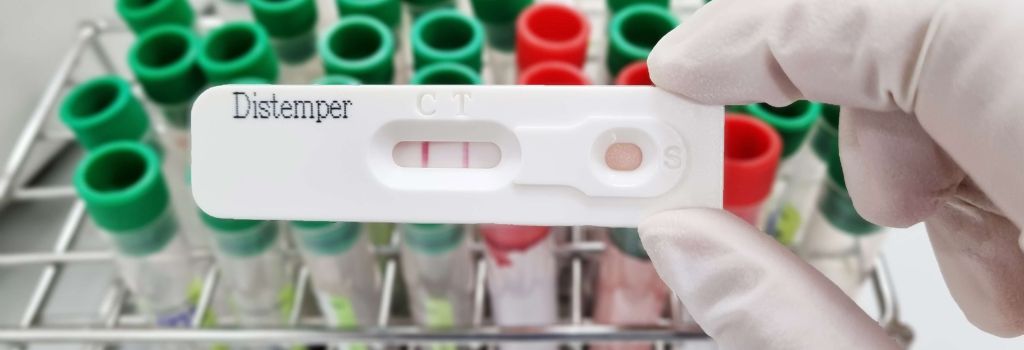Vaccines are one of the most influential medical advancements to human health ever made, responsible for millions of infants living into adulthood. However, recent pushback against vaccines, known as "vaccine hesitancy," has affected both human and animal vaccine acceptance. Vaccine hesitancy refers to the reluctance or refusal to vaccinate despite the availability of vaccines. In fact, according to research from Boston University, nearly “40% of respondents believed that canine vaccines are unsafe, more than 20% believed these vaccines are ineffective, and 30% considered them to be medically unnecessary.”
Vaccines are one of the most powerful preventative tools for our pets' health. However, vaccines must be selected carefully, administered at the right time, and understood within the context of the pet's health and environment to maximize their benefit and minimize risks. Understanding how vaccines work is crucial in this process.
Understanding How Vaccines Work
It's essential to know what vaccines can and cannot do. This includes understanding how the immune system responds to vaccines, which vaccines are appropriate for your pet's lifestyle, and how they should be handled and administered. Vaccines play a vital role in preventing infectious diseases, and with growing vaccine hesitancy among pet owners, it's more important than ever for owners to grasp vaccinology and the reasoning behind the vaccination protocols veterinarians recommend for our pets.
The 4 Types of Veterinary Vaccines
There are four primary types of veterinary vaccines:
- Modified Live (Attenuated) Vaccines: These contain altered and weakened forms of the disease-causing organism. They stimulate an immune response without causing the disease.
- Inactivated (Killed) Vaccines: These contain dead bacteria or viruses, which help the immune system recognize and develop immunity, without causing the disease.
- Recombinant Immunizing Agents: These are made of a live attenuated (weakened) viral or bacterial strain used as a vector to carry the gene or genes encoding the desired vaccine antigens.
- Toxoid Vaccines: These protect against the toxin produced by the offending bacteria.
Vaccines can also be classified by whether they protect against viral diseases or bacterial diseases, the latter being referred to as bacterins.

Tools for Determining the Best Vaccination Schedule for Dogs & Puppies
Puppies are born with a "naive" immune system, meaning they have minimal immunity to viruses and bacteria. Their initial immunity comes from their mother's colostrum, which they need to receive within the first 24 hours after birth. If they don’t get enough colostrum, they risk "failure of passive immunity," making them vulnerable to illness. If necessary, colostrum, plasma, or serum from donor dogs can be administered to boost immunity.
Pups that have received adequate amounts of colostrum when under 24 hours old will have immunity to what their mothers are immune to – this is called “passive” immunity. As pups mature, the maternal antibodies slowly degrade. As the antibodies drop, the pup’s immune system can begin to mount its own response – this is called “active” immunity.
The challenge in vaccinating puppies is timing the administration of vaccinations so their immune systems can produce antibodies before exposure to serious diseases. A series of vaccinations is typically administered to allow the puppy to develop active immunity.
Titers & Nomograms
Some breeders use a nomogram to determine the best time to vaccinate puppies. A nomograph is a blood test that estimates how much of a mother dog's antibodies are passed to her puppies through her milk. This test helps determine when a puppy is no longer protected by its mother's antibodies and is ready to be vaccinated. The disadvantages are the cost of the test and that it may not be practical to test every puppy. The reality is that not all pups in all litters receive protective amounts of colostrum. This can occur if a pup is weak and an ineffective nurser, if it is pushed off a good spot at the nursing bar, or if it is born late in a large litter and misses out on vital colostrum, among other reasons.
To test maternal immunity, it is advised to avoid collecting blood from the dam within two weeks before or after whelping, as antibodies at this time will be artificially low due to their transfer to the puppies.
A vaccination titer is a blood test used to measure the level of antibodies present in an animal's bloodstream after vaccination. This test helps determine whether the animal has developed sufficient immunity to a specific disease, indicating whether a booster vaccine is needed. Titers are often used to assess immunity against diseases like rabies, distemper, and parvovirus in dogs. While a high titer result generally suggests that the animal is adequately protected, a low or absent titer may signal the need for additional vaccinations. This method is most often used for pets that may have a weakened immune system, or for those whose response to vaccines needs to be monitored more closely. However, titers are not always accepted as a substitute for vaccination in certain cases, such as with rabies, where legal requirements often mandate regular booster shots regardless of titer levels.
Veterinary & Health History
Your puppy's health history is critical when determining the appropriate vaccination schedule. Factors such as underlying health conditions, medications, or illnesses can affect the vaccine recommendations. In some cases, vaccines may need to be delayed.
For instance, temporary pauses in vaccination may be needed during pregnancy, illnesses or when a dog is on short-term medication. In cases of immune-mediated diseases such autoimmune hemolytic anemia or thrombocytopenia, sterile meningitis, lupus, and immune-mediated polyarthritis, vaccines may not be advisable.
Be sure to provide a complete medical history to your veterinarian, as this can help prevent adverse reactions or complications related to vaccinations.
How Many Vaccines Do Puppies Need?
Puppies need a series of vaccines to develop adequate antibodies and protection. Vaccination should begin between 6 and 8 weeks of age, and be repeated until the puppy is 16 to 20 weeks old. This ensures that the pup has had repeated exposure to the vaccine antigens as the maternal antibodies wear off. This allows their immune system to develop their own active immunity. If vaccinations are started too late or stopped too early, the puppy may not develop the necessary immunity and could be at risk for preventable diseases.

Why Dogs Need Boosters
Over time, a dog's antibody levels may decline, which is why booster vaccinations are necessary. For young adults, boosters are generally administered about a year after completing the initial vaccine series. After the first year, some vaccines require annual boosters (e.g., leptospirosis, Lyme disease, bordetella, influenza), while others may only need a booster every three years (e.g., rabies, distemper, adenovirus, parvovirus, parainfluenza). It's essential to stay on top of boosters to ensure long-term immunity.
What Happens If You Don’t Vaccinate Your Dog?
When puppies aren’t vaccinated, or miss key, core vaccinations, they become vulnerable to diseases that are completely preventable.
In addition to the health consequences for your puppy, you, as the owner, could also be on the hook for legal consequences in your area if you fail to administer certain vaccinations to your pup. For example, most states have requirements in place for all pets to regularly receive a rabies vaccination and register with the state. Failing to comply could result in fines and other penalties.
Vaccination Failures: When Things Don’t Go According to Plan
Though most puppies develop adequate immunity from completing a standard vaccination series, some may fail to respond properly. This is more common in certain breeds, but often inadequate response is due to being ill, malnourished, or stressed as we commonly see in shelter or rescue pups. It's essential to monitor vaccine responses and work closely with your veterinarian to ensure your dog's protection.
For rabies, most states do not accept a titer test as an alternative to the vaccine. While some dogs may have long-lasting immunity beyond the standard 3-year interval, rabies vaccines are still required by law.
Working With Your Veterinarian for the Best Vaccination Plan
Vaccinating your dog is one of the best ways to ensure their long-term health and prevent the spread of infectious diseases. While the world of vaccines can be complex, your veterinarian is your best resource in developing a vaccination plan tailored to your dog's health, lifestyle, and risk factors. While side effects from vaccines are generally rare, the benefits far outweigh the potential risk.
Taking an active role in your dog's preventative care through vaccination not only helps protect your pet but also contributes to a healthier pet community.
Stay tuned for the next part of our series on pet vaccinations, where we'll dive into vaccination schedules and the differences between core and non-core vaccines.
If you have questions and you'd like to reach out to us, you can call us directly at (218) 692-4400, or you can email us at [email protected]. Don't forget to follow us on social media Facebook, Instagram.

